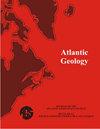Ring-shaped morphological features and interpreted small seamounts between southern Quebec (Canada) and the New England seamounts (USA) and their possible association with the New England hotspot track
IF 0.9
4区 地球科学
Q2 GEOLOGY
引用次数: 3
Abstract
Enhancements of recently available high-resolution multibeam echosounder data from the western Gulf of Maine and Atlantic continental margin and light detection and ranging (LiDAR) and digital elevation model data from southeastern Quebec (Canada) and the northeastern United States have revealed numerous ring-shaped morphological features and interpreted small seamounts between the Monteregian Hills igneous province and the New England seamounts. The morphological features onshore are mainly ring-shaped depressions, several of which surround mapped igneous intrusions in the Monteregian Hills igneous province and White Mountain magma series. Most of the rings offshore are also depressions, although a few rings are curved ridges above the seafloor. The largest ring in the western Gulf of Maine is the 30-km-diameter Tillies ring that lies 20 km east of Cape Ann, MA. Several small (<3 km in diameter) round, flat-topped submerged hills that we interpret to be volcanic necks are also present beneath the western Gulf of Maine. The rings between Cape Cod and the continental slope are more subtle because of thicker sediments and poorer spatial resolution of the sonar data in this area. The southernmost ring-shaped features are located on the continental slope and upper continental rise and coincide with the northwestern end of the New England seamount chain. The concentration of these features between the Monteregian Hills igneous province and the New England seamounts suggests that they are igneous features that may be associated with the New England hotspot track.魁北克南部(加拿大)和新英格兰海山(美国)之间的环形形态特征和解释的小型海山,以及它们与新英格兰热点轨道的可能联系
最近从缅因湾西部和大西洋大陆边缘获得的高分辨率多波束回声测深仪数据,以及从魁北克东南部(加拿大)和美国东北部获得的光探测和测距(LiDAR)和数字高程模型数据的增强,揭示了许多环形形态特征,并解释了蒙特雷吉山脉之间的小型海山丘陵火成岩省和新英格兰海山。陆上的形态特征主要是环形凹陷,其中几个凹陷围绕着蒙特雷吉亚山火成岩省和白山岩浆系列的已绘制的火成侵入体。海上的大多数环也是凹陷,尽管也有少数环是海底上方的弯曲山脊。缅因湾西部最大的环是直径30公里的蒂利斯环,位于马萨诸塞州安角以东20公里处。缅因湾西部也有几个小的(直径<3公里)圆形平顶淹没山丘,我们认为这些山丘是火山颈。由于该地区沉积物较厚,声纳数据的空间分辨率较差,鳕鱼角和大陆坡之间的环更为微妙。最南端的环形地貌位于大陆坡和上陆坡,与新英格兰海山链的西北端重合。这些特征集中在蒙特雷吉亚山火成岩省和新英格兰海山之间,表明它们是可能与新英格兰热点轨道有关的火成岩特征。
本文章由计算机程序翻译,如有差异,请以英文原文为准。
求助全文
约1分钟内获得全文
求助全文
来源期刊

Atlantic Geology
GEOLOGY-
CiteScore
2.10
自引率
18.80%
发文量
0
审稿时长
>12 weeks
期刊介绍:
Atlantic Geology (originally Maritime Sediments, subsequently Maritime Sediments and Atlantic Geology) covers all aspects of the geology of the North Atlantic region. It publishes papers, notes, and discussions on original research and review papers, where appropriate to the regional geology.
 求助内容:
求助内容: 应助结果提醒方式:
应助结果提醒方式:


